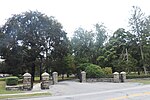Tibbetts Brook Park

Tibbetts Brook Park is a 161-acre (65 ha) park located in the Lincoln Park section of Yonkers in Westchester County, New York. Opened in 1927, it was one of the first developed parks in Westchester County and currently serves residents with activities that include swimming, hiking, sports, nature watching and fishing.The park was named for George Tibbetts, a Briton who had settled the land in 1668. Tibbetts is bordered by the Cross County Parkway to the north, Saw Mill River Parkway to the west, McLean Avenue to the south and Midland Avenue to the East. Tibbetts Brook Park is .6 miles (1 km) north of Van Cortlandt Park along South County Trailway, and Tibbetts Brook crosses north-south through the park on its way to the Harlem River.the park is not bordered by McLean ave to the south, it is bordered by Jervis rd to the south The park is the home ground of the New York Magpies in the USAFL.
Excerpt from the Wikipedia article Tibbetts Brook Park (License: CC BY-SA 3.0, Authors, Images).Tibbetts Brook Park
County Park Road Path, City of Yonkers
Geographical coordinates (GPS) Address Nearby Places Show on map
Geographical coordinates (GPS)
| Latitude | Longitude |
|---|---|
| N 40.925833333333 ° | E -73.877777777778 ° |
Address
Tibbetts Brook Park
County Park Road Path
10704 City of Yonkers
New York, United States
Open on Google Maps






